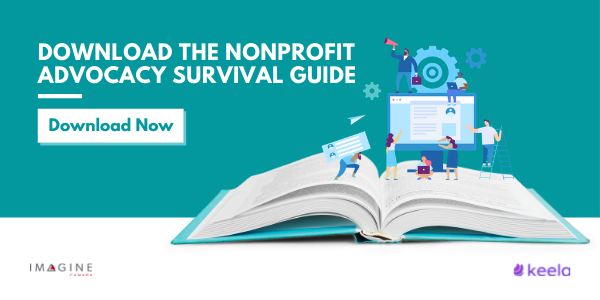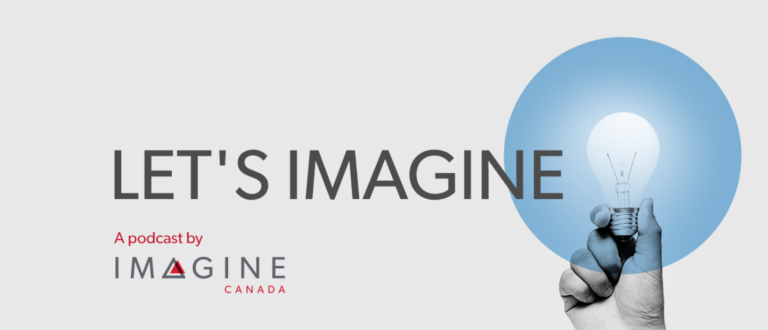Photo credit: MS Society of Canada
360° SPONSORED CONTENT
Trying to spark change and advance policy priorities, even in a small way, is a challenging task for any nonprofit organization. Working with the federal government to spark broad social change is especially daunting.
But your voice matters, and it deserves to be heard by decision-makers. By engaging in advocacy, you can create the change you want to see in the world.
Below we’ll explore three key ways to spark change at the federal level:
- Create an alliance
- Connect with your MP
- Go digital
These tactics, especially when used together, have the power to maximize your resources, get you in front of decision-makers, and make a difference in the areas that matter most to you.
Before you get started - what’s allowed for charities?
Before we get into some great ways to spark change, let’s go over what is and isn’t allowed for charities and nonprofits in Canada.
Generally, there are no limits on the advocacy and public policy activities of nonprofit organizations.
However, the Canadian Revenue Agency (CRA) has defined rules of engagement for charities who wish to engage in public policy dialogue and development activities (PPDDAs) such as advocacy. These allowable activities include: developing proposals for government to change, get rid of, or develop new laws and policies; reacting to government proposals and actions; participating in the process through written submissions, committee appearances, and the like; meeting with elected officials and public servants to advocate for change; and urging the public to get involved in an issue through things like petitions, rallies, or letter-writing campaigns. Check out the formal list of activities here.
As long as the public policy work you do is in furtherance of your charitable purpose, as accepted by the CRA, there are no government-imposed limits on how much of this work you do. As long as your board, donors, and other funders are with you, public policy work is one of the tools you can use to achieve your purpose. Theoretically, your charity could devote 100% of its resources to PPDDAs that pursue its stated charitable purpose.
However, keep in mind that at no point can charities support or oppose a political party or candidate. Charities must remain non-partisan in their PPDDAs. This includes both direct and indirect support, which you can read more about here.
Before engaging in PPDDAs, consult the CRA website to learn more about the rules and regulations surrounding advocacy, including other sets of rules that apply (for instance, during elections).
Next step: Clarifying your ‘ask’
Before you start advocating, it is crucial that you clarify your ‘ask’ (or, recommendation) by answering the following questions:
- What change are you trying to spark?
- What policy are you seeking to influence?
- How would your ask benefit the community you serve?
- Why should your audience care? What’s “in it” for them?
- What is your “elevator pitch” should you encounter a busy decision maker?
Clarifying your ask will not only help you plan your advocacy efforts better, it will also ensure that your audience better understands your needs and is equipped to help you achieve your goal. Once you’ve pinpointed your ask, start by creating a one-pager or a background document to share with your advocacy audience.
Looking for more resources to advance your advocacy campaign? Download Imagine Canada and Keela’s Nonprofit Advocacy Survival Guide for practical resources that will help you find the right tools and connect with the right people.
1. Create a Strategic Alliance
Many nonprofits are stretched so thin that it can often be challenging to fulfill day-to-day responsibilities, let alone create a social movement.
However, it’s called social change for a reason: it involves a network of people and organizations, many of whom you can lean on for support. Leveraging the connections and resources within an organizational network is a great way to set yourself up for success.
Strategic alliances can be structured as informal unions or as recognized legal entities. Try to determine your alliance’s structure by identifying its end goals. Alliances can serve several purposes:
- Creating a shared policy agenda
- Coordinating a specific campaign
- Sharing resources, expertise, and information
- Amplifying each other’s voices
Sharing a common purpose, organizing around it, and speaking in a unified voice can enable organizations to spark change in a powerful way.
The main benefit of joining forces isn’t just so you can sound cool saying, “I’m in an alliance that will change the world.” Alliances present a variety of benefits for advancing the cause of the organizations involved, such as:
- Increased credibility: Obviously, the voices of multiple nonprofits will be louder than any lone organization.
- The power of many: When nonprofits work together, they maximize each other’s strengths and create something more significant than themselves.
- Maximized resources: What one organization may have a shortage of, another may have a surplus. Alliances provide nonprofits with more of the resources and expertise they need to make an impact.
- Unified idea creation: Having the brainpower of a unified coalition ensures that any nonprofit advocacy campaign will be thought out and have a concentrated agenda.
Historically, alliances formed around common goals, policy objectives, or visions have been powerful tools in the nonprofit sector.
To exemplify a strategic alliance, let’s look at the People-Centred Economy Group (PCE Group).
Since 2010, the PCE Group has brought together nonprofits, social enterprises, and co-operatives from all over Canada to advocate for a sustainable and inclusive economy. Together, the PCE Group’s members employ millions of Canadians and contribute significantly to the Canadian GDP.
In the summer of 2020, the group used its collective voice to put forth its recommendations for the 2021 Federal Budget.
The PCE Group is a highly organized and structured example of a strategic alliance. But, remember that partnerships can take many forms.
Here are a few more ways to make the most out of your sector alliance:
- Set up joint meetings with elected officials
- Send joint letters to officials
- Organize a group Hill Day
- Send a statement to your local newspaper
- Co-fund a marketing campaign
- Submit a joint pre-budget submission. To get started, check out Imagine Canada’s pre-budget consultation cheat sheet and toolkit.
Alone, it’s difficult to find the time, resources, and expertise necessary to make a difference. However, by creating an organizational alliance, you have the power to create something more valuable than the sum of its parts.
2. Connect With Your MP
Building connections on Parliament Hill is crucial to effecting meaningful change. The best way to get your foot in the door is by developing a relationship with your local Member of Parliament (MP).
Your MP's role is to represent the interests of their constituencies. That means you! Consider how your MP and organization can work together to support the communities you both serve.
Finding your MP
The House of Commons has an easy-to-use tool to help you find your local MP and their contact information. You can find your MP by either entering their name, your electoral region, or your postal code.
Connecting With Your MP
We recommend connecting with your MP regularly. Consider meeting in person, virtually, or sending them a message via email, social media, or letter mail.
Check out Keela’s Impact Story Tool Kit to ensure that you don’t leave out any crucial elements in the stories you share with your MP. This tool kit provides you with a story checklist, story outlines, and social media templates.
Engaging Your MP Effectively
Give your cause a fighting chance to be heard. Approach your MP regularly to build allyship and request meetings well before any decision-making periods that could advance your mission. Keep in mind that policy decisions usually take a considerable amount of time.
Remember, your MP has interests, passions, and a professional background like anyone else. You may be able to draw on these areas to find common ground. Research your MP’s background and try to answer a few of these crucial questions:
- How do our priority areas align?
- How does the result I’m seeking help them to achieve their goals?
- How many of their constituents are also our stakeholders?
- What has motivated this MP in the past?
- What are their interests and passions?
Also, ensure that you’re providing your MP with something they can act on. Whether you’re advocating for your cause or giving timely updates, ensure that you’re presenting them with actionable insights.
For example, ask your MP to send a letter to Cabinet, share your latest research with another MP, table a petition, set up a meeting between you and some of their colleagues, or ask a question during Question Period in the House of Commons.
3. Go Digital
The advocacy landscape is changing rapidly, and nonprofits need to adapt accordingly. Many programs and tools enable organizations to contact lawmakers more efficiently, tell compelling stories, sign petitions, and do a whole lot more. With this efficiency comes the ability to better motivate stakeholders to take action virtually.
Let’s take a look at Dying With Dignity Canada’s (DWDC) digital advocacy campaign that led up to the 2019 federal election - a great example of going digital.
DWDC released a comprehensive election toolkit that launched their digital-advocacy email-a-candidate campaign.
DWDC ensured that their supporters understood their specific calls to action and drafted an email template so their supporters could virtually reach out to their own local MPs.
Subject: Constituent meeting request re: end-of-life rights [insert your postal code]
Dear Mr./Ms./Dr. [candidate last name],
I am writing to request a brief meeting with you to discuss end-of-life rights and choices, including the right to medical assistance in dying. As a voter and resident of your riding, I would appreciate 15 to 20 minutes to learn more about your views on this important issue.
Please let me know when would be best for your schedule.
Thank you,
[Your name]
[Your postal code]
[Your phone number/email/contact information]
The persistence of DWDC seems to have paid off as, on March 17, 2021, the federal government expanded the eligibility criteria for medical assistance dying in response to the Superior Court of Québec’s 2019 Truchon decision.
Although many campaigns won’t operate on the same scale as DWDC, this doesn’t mean you can’t make a significant impact with the resources at your disposal. There are several easy-to-use tools that will help you make the most of your digital campaign.
New Mode, for example, is a multi-channel platform that organizations, campaigns, and causes can harness to gain access to local, provincial, and federal elected officials. The New Mode team also provides free training so that you can rock your campaigns!
Also, check out Phone 2 Action. This platform provides a host of tools to facilitate advocacy efforts, making it easy for your organization to acquire, engage, and mobilize your advocates. Phone 2 Action’s robust database and sophisticated analytics will provide you with the actionable insights and organizational tools needed to take your campaigns to the next level.
Looking for more information on how to take full advantage of your social media platforms? Watch Keela’s webinar on the best ways to think about, plan for, and interact on social media to maximize your efforts.
Each of the strategies outlined above will give your advocacy efforts the boost they need to make a difference at the federal level. Creating an alliance, connecting with your MP, and taking advantage of your digital resources will turn your words into policy!
Guest contributions represent the personal opinions and insights of the authors and may not reflect the views or opinions of Imagine Canada.
When Jack isn't cheering for the Raptors or watching a movie, he’s studying the social sector and producing content for nonprofit professionals. As a Nonprofit Research Analyst at KIT for Fundraisers, an AI-powered insights toolkit, he is especially interested in finding ways to optimize the power of nonprofit software like Keela.




